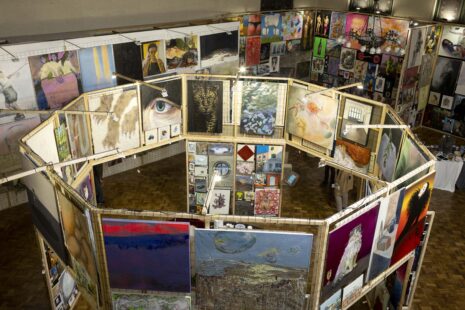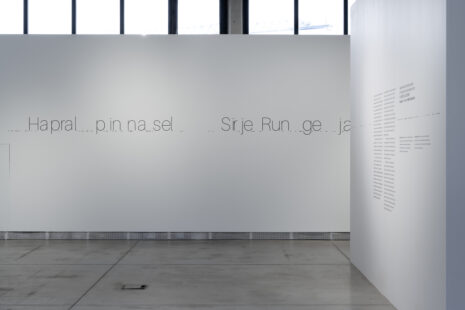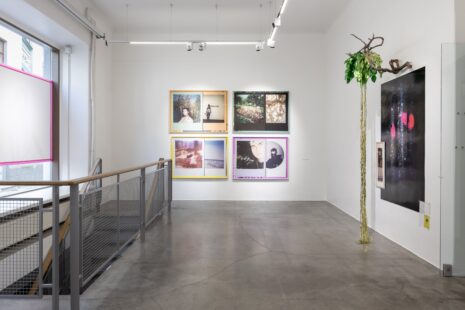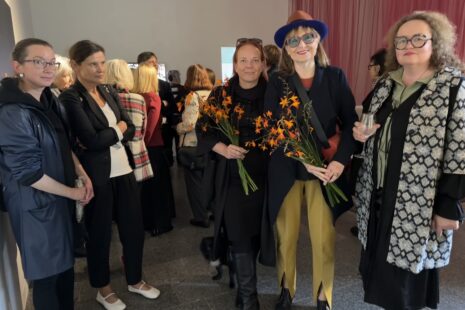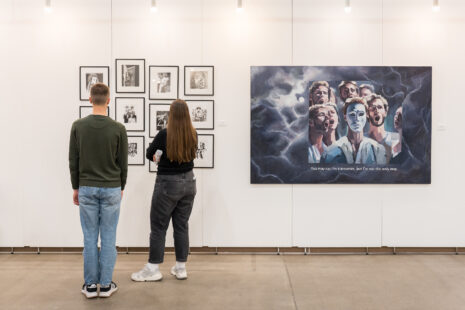By introducing yourself you mentioned that besides participating in exhibitions you are practising plein air painting, too. I can see that this comes from your love for nature, but tell me, is painting outdoors something special for artists in Lithuania nowadays? Is the most contemporary visual art born indoors, in the studio?
I’m probably not the only one who finds inspiration in nature. And I don’t think it’s only Lithuanian artists who like to create in nature. There is no doubt that Lithuanian nature is very inspiring and beautiful. Our forests are full of eco-systems and beauty, which for many people, especially during the quarantine period, was a rediscovered treasure. In summer, many artists retreat to the sanctuary of nature to escape the noise of the city, which becomes a kind of meditation in a natural environment. Which is also close to my heart. However, this is not categorically that way, most of the works are born in the studio, especially when it comes to the graphic works. Because graphics requires certain special tools and equipment.
My last exhibition in Vilnius, called Saudade, was held at the „Museum of Energy and Technology“. It is precisely in this exposition that I am talking about today, which is an unconditional ruler – created from yesterday’s longing and tomorrow’s illusions.
The green bunny becomes a symbolic mediator between yesterday and tomorrow, between the natural background and the viewer, between natural harmony and the user.
The metaphor of a running person in everyday life is like becoming a fast-paced restless bunny, only the finish line is different. We live for the tomorrow we create now. And what will happen tomorrow depends only on us – will green bunnies run around the green meadows, which will be caught by our green subconscious childhood…?
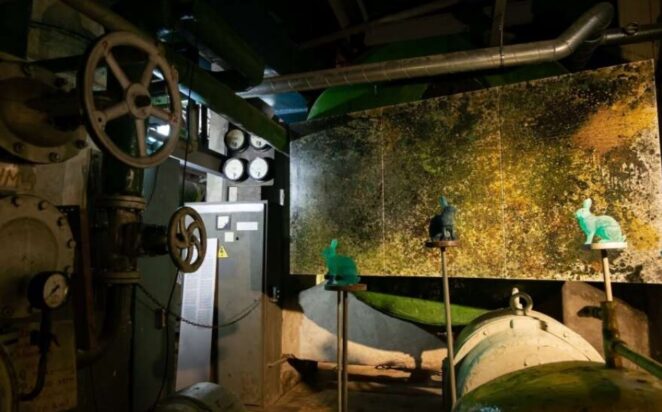
Saudade, 2022
What is the difference from your perspective – what do you think, feel and sense when making art in different locations?
I wouldn’t think that location influences the birth of my works. I am the same person wherever I am, whether in nature, in the studio or at home. A kind of creative process is always going on, whether I’m listening to music, at an exhibition, talking to people, making pancakes for the kids… I would say there is a constant inner monologue, where an album of ideas, experiences, impressions is accumulated, which then turns into a creative event in the studio, a liberation, which results in the creation of a work.
Besides the group exhibitions you have had two solo shows, first of them being “Matters of (si)liberation” in 2021. Sounds like an intriguing play of words! Tell us more about this!
I have always been interested in the traces left by people. The ones that appear over the years – when things take on new forms, they transform, they change. Whether it’s an old man’s sill, or a worn-out stick used by a worn-out man for picking, or a worn-out doorpost. When wooden (and not only wooden) surfaces become dulled as a result of years of activity, human energy permeates. They seem to coexist, to become one. That’s why I chose the floor as the object, the base on which life takes place on a daily basis, with a direct and immediate connection to people’s everyday life and activities. I wasn’t looking for a surface to walk on for the sake of it, but I looked at this contact in a different way. The most important object was the personality, whose activity left that mark on the floor. The importance, the meaning and, ultimately, the result of those activities. Then there is a different perception of reality, a different point of view on the objects around us. They take on a tinge of uniqueness, sometimes even a sense of the sacred, which carries a memory. Their lasting value is also changed. It all depends on our point of view, its presentation.
I have chosen three different destinies, three different spheres of human activity and life, three different worldviews. They are the creator (writer), the priest and the prisoner.
The first place is the creator’s work studio, where the artist left his mark on the floor after he left. The place where he used to sit every day and write at his desk. Over the years, working in the same place – on the floor – a mark was left. I like to call this creative process imprisonment. Because the man devoted his life to writing, day after day, year after year, always at the same time, he would come to the studio and sit at his desk. He gave himself over to putting his thoughts into a book. This kind of imprisonment leads to liberation, because self-isolation produces creativeness, the result that was intended. In the second case (that of the priest) the result is different – more moral, more spiritual. It is immaterial, but no less important. And here I call imprisonment a duty. Taking vows and doing one’s duty to the end. And liberation becomes the neutralisation of one’s inner burdens. The third, the case of the prisoner, is different – it is a direct imprisonment – although it also becomes an inner imprisonment. In this case, the aim is direct liberation.
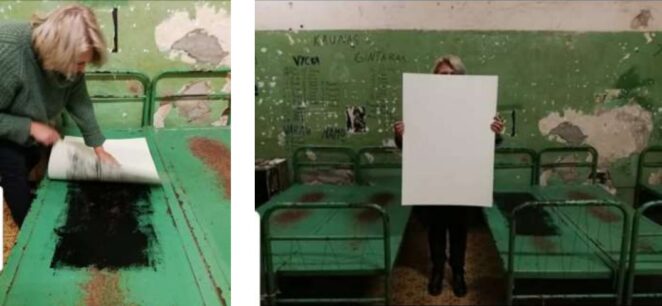
Documentation of (im)detention, 2020
The whole process, the consequences and the outcome have a negative connotation, but the hope of reaching a conclusion remains. My works are direct imprints from the surfaces of the studio, the church auditorium and the prison floor. They are the result of direct contact, of touch. In capturing this, I wanted to give it a new subtext, a survival meaning. I was trying to feel the energetic charge, to purify it by transferring it into another matter. To become a kind of mediator and archivist. To document, to testify with graphic means the transfer and preservation of a new material object. To make prints that carry different emotional energies, as exemplary witnesses of the everyday human condition. In addition to the results of my activity or lifestyle, I want to preserve the physical legacy of human energetic action. To extend its history, albeit concentrated and static.
And the second took place this year – “Emptiness, banished thoughts“. This sounds like the winning work of the NOBA contest (public award) – „Emptiness and energy“. You have said that the easiest way to show emptiness is to show nothing so it could be sensed instead. Could you explain it a bit more to our reader?
Indeed, it is not easy to expose the void. And not showing it at all would be the most accurate way of revealing it. Energy is the fullness that creates things and they appear in emptiness. The whole Cosmos is a field of energies, where from time to time these energies come together and create, for example, the Sun, the planets and us. The void is the medium in which energy is born and in turn from that energy things continue to be born.
The void is the beginning of the beginning. In the language of symbols, for me, the void is a vessel of water – life itself.
Today we are often surrounded by an excess of things. Oversaturation breeds alienation. Therefore, the theme of emptiness becomes for me a metaphor for the endless, as opposed to today’s world of excess and over-saturation. Energy would be that multiplicity. I am trying to go deeper into the positive emptiness, the formlessness, the vacuity. An emptiness that is not intimidating, not tormenting, not intrusive, and not out of lack. Emptiness through renunciation. As a cleansing and a release for new creative impulses. An emptiness in which you rediscover yourself.
In the case of this work you are talking about two contexts. Firstly the creative one where you use different printmaking techniques – etching, mezzotint and author’s technique. You also stamp a “naturalness” into your works by using natural elements – plants, insects, fish gills. How does the gathering of this material look like for you?
First of all, all the elements appearing in my works catch my eye with their natural graphic forms. This is perfection in simplicity: be it long-legged mosquitoes, cotinus or pike gills… I still find beehives very graphic. I just like to collect something weird and unusual and create other immortalization opportunities for them as possible. This is how the natural objects I have collected end up in my works, they get a second life, a new story.
There was also a sculptural object involved, an extension of a graphic work. I am afraid that the audience of this particular contest did not see it. So tell us about this as well, and of course – show the pictures!
Yes. It all started with an etching that I did for the Intertwinings and interactions exhibition. It was part of a joint international project between four art academies in Belgrade, Wroclaw, Gdansk and Vilnius. The sculpture-object was born as an extension of this etching in 3d space. These works initiated the title of the exhibition, which took place at the Artifex Gallery – Emptiness, expelled thoughts. This was one of the meanings that everything starts with our thoughts, with what we think, which then gives birth to what we do.
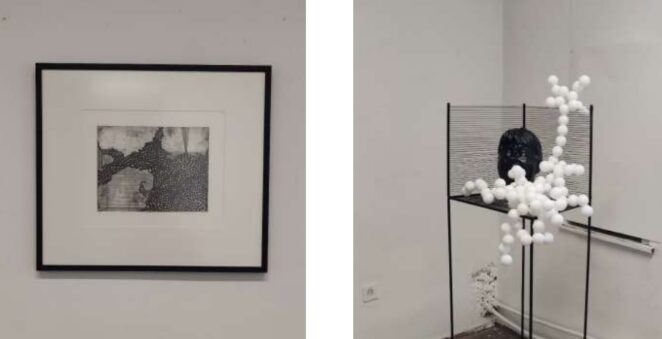
Emptiness, Expelled Thoughts…, 2021
And the other context of this work was a personal story which goes back to your childhood. Your world consisted of libraries, collections of paintings, sheet music and records that your parents considered their possessions. What painting do you remember the best from that time?
My childhood home was full of paintings. They surrounded my non-committal childhood, giving me different visions of colours and emotions. It would not be easy to single out any of them. But there are a few that stick out more, such as a painting by a Lithuanian primitivist painter. I kept wondering why the rooster in the painting is bigger than the grandmother and the house. It was a Lithuanian village scene. Another painting provoked romantic thoughts because it depicted a forest glade, quite close to the Brothers Grimm fairy tale motifs, albeit not at all scary, where a young couple having a romantic time. I remember a number of scenographies of mise-en-scene performances – one of the more striking ones was King Lear with his daughters.
This is the time when you first met the void – when your father died, the house was emptied and you had to face the possibility of a new life opening up. Today you are using this kind of emptying process in your creation and you are grateful that it has freed you from attachment to things. Is this something you would recommend practising for everybody else, too? I mean – letting go of things is kind of a contemporary mantra.
In fact, everyone is free to make their own choices in life. I can only speak for myself. But from a more global perspective, yes, today we have clearly too much of everything. Yes, bouncy castles are too big today. Our consumption exceeds our needs. It’s good that good things become fashionable, that we can not buy, but exchange, not throw away, but give to those who don’t have it. Thinking not only about ourselves, but also about others brings us closer together.
What happens tomorrow depends on today. Ego changes to eco.
Your parents’ collection bears your christian name (Laura Maria), it was a possession for them, but not for you. How do you feel, did they possess you, too?
Living in a family of artists is already a kind of challenge. When dad sat at his desk all day, and mom’s performances ended late in the evening. And their hobbies only diversified my everyday life, even unusual hobbies. Maybe one of those was my name Laura-Marija – collecting meaningful things. As for the name itself, I think it is primarily the transfer of a certain meaning, feelings, codes to the bearer of the name. In a way, my parents didn’t separate me from my name. I always felt important and loved by them. Love and attention first of all starts with a person, and a name is like a verbal meaning. For my parents, F. Petrarka’s Laura, in no way became more important than myself.
And finally – besides art studies you have also taken piano classes. Which would be the best piano piece to illustrate the void in your sense?
Most likely, it would be J.S. Bach’s triple fugue in C major – polyphonic, restrained, deep and multilayered, just like emptiness, which is difficult to picture but easier to feel. As in my works, by showing energetic and excessive curves, I aim to reveal the need for longing, calmness, silence, longing… Using the method of opposition – I reveal emptiness through energetic oversaturation, through abundance I reveal what brings us back to ourselves, to our essence, to what is important.
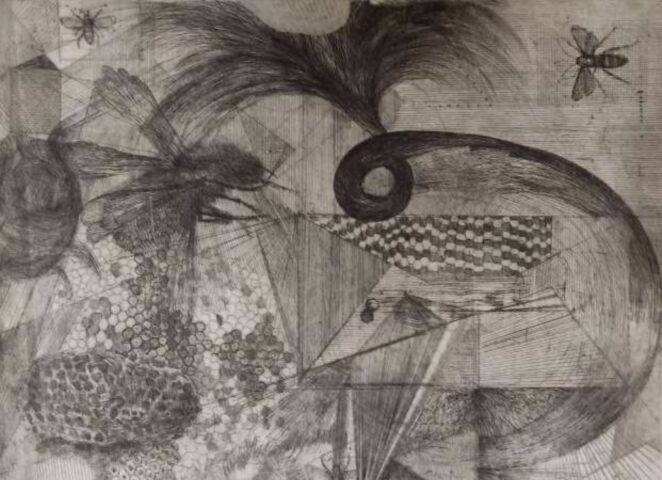
Emptiness, Expelled Thoughts…, 2021


